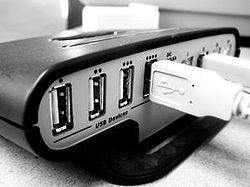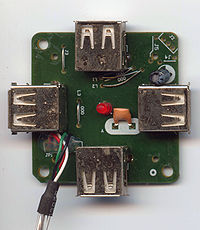
USB hub
Encyclopedia


Universal Serial Bus
USB is an industry standard developed in the mid-1990s that defines the cables, connectors and protocols used in a bus for connection, communication and power supply between computers and electronic devices....
port into several so that there are more ports available to connect devices to a host system.
USB hubs are often built into equipment such as computers, keyboards
Computer keyboard
In computing, a keyboard is a typewriter-style keyboard, which uses an arrangement of buttons or keys, to act as mechanical levers or electronic switches...
, monitors
Computer display
A monitor or display is an electronic visual display for computers. The monitor comprises the display device, circuitry, and an enclosure...
, or printers
Computer printer
In computing, a printer is a peripheral which produces a text or graphics of documents stored in electronic form, usually on physical print media such as paper or transparencies. Many printers are primarily used as local peripherals, and are attached by a printer cable or, in most new printers, a...
. When such a device has many USB ports they all usually stem from one or two internal USB hubs rather than each port having independent USB circuitry.
Physically separate USB hubs come in a wide variety of form factors: from external boxes (looking similar to a network hub) connectible with a long cable, to small designs that can be directly plugged into a USB port (see the 'compact design' picture). In the middle case, there are "short cable" hubs which typically use an integral 6 inch cable to slightly distance a small hub away from physical port congestion and of course increase the number of available ports.
Laptop computers may be equipped with many USB ports, but an external USB hub can consolidate several everyday devices (like a mouse and a printer) into a single hub to enable one-step attachment and removal of all the devices.
Inverse or Sharing Hubs
Also available are so-called "sharing hubs", which effectively are the reverse of a USB hub, allowing several PCs to access (usually) a single peripheral. They can either be manual, effectively a simple switch-box, or automatic, incorporating a mechanism that recognises which PC wishes to use the peripheral and switches accordingly. They cannot grant both PCs access at once. Some models, however, have the ability to control multiple peripherals separately (e.g., 2 PCs and 4 peripherals, assigning access separately). Only the simpler switches tend to be automatic, and this feature generally places them at a higher price point too. Modern KVM switchKVM switch
A KVM switch is a hardware device that allows a user to control multiple computers from a single keyboard, video monitor and mouse. Although multiple computers are connected to the KVM, typically a smaller number of computers can be controlled at any given time...
es can also often share USB devices between several computers.
Physical layout

USB ports are often closely spaced. Consequentially plugging a device into one port may physically block an adjacent port, particularly when the plug is not part of a cable but is integral to a device such as a USB flash drive
USB flash drive
A flash drive is a data storage device that consists of flash memory with an integrated Universal Serial Bus interface. flash drives are typically removable and rewritable, and physically much smaller than a floppy disk. Most weigh less than 30 g...
. A horizontal array of horizontal sockets may be easy to fabricate, but may cause only two out of four ports to be usable (depending on plug width).
Port arrays in which the port orientation is perpendicular to the array orientation generally have fewer blockage problems. External "Octopus" or "Squid" hubs (with each socket at the end of a very short cable maybe 2 inches long), or "star" hubs (with each port facing in a different direction, as pictured) avoid this problem completely.
Length limitations
USB cables are limited to 3m for low-speed USB 1.1 device. A hub can be used as an active USB repeater to extend cable length for up to 5m lengths at a time. Active CablesActive Cables
Active cables are copper cables for data transmission that use a silicon chip to boost the performance of the cable. Without a chip, a cable is considered a 'passive' cable. Passive cables are liable to degrade the data they carry, due to such "channel impairments" as attenuation, crosstalk and...
(specialized connector-embedded one-port hubs) perform the same function, but since they are strictly bus-powered, externally powered (non-bus-powered) USB hubs would likely be required for some of the segments.
Power
A bus-powered hub is a hub that draws all its powerElectric power
Electric power is the rate at which electric energy is transferred by an electric circuit. The SI unit of power is the watt.-Circuits:Electric power, like mechanical power, is represented by the letter P in electrical equations...
from the host computer's USB interface
Interconnection
In telecommunications, interconnection is the physical linking of a carrier's network with equipment or facilities not belonging to that network...
. It does not need a separate power connection. However, many devices require more power than this method can provide, and will not work in this type of hub.
USB current (related to power) is allocated in units of 100 mA up to a maximum total of 500 mA per port. Therefore a compliant bus powered hub can have no more than four downstream ports and cannot offer more than four 100 mA units of current in total to downstream devices (since the hub needs one unit for itself). If a device requires more units of current than the port it is plugged into can supply, the operating system usually reports this to the user.
In contrast a self-powered hub is one that takes its power from an external power supply
Power supply
A power supply is a device that supplies electrical energy to one or more electric loads. The term is most commonly applied to devices that convert one form of electrical energy to another, though it may also refer to devices that convert another form of energy to electrical energy...
unit and can therefore provide full power (up to 500 mA) to every port. Many hubs can operate as either bus
Computer bus
In computer architecture, a bus is a subsystem that transfers data between components inside a computer, or between computers.Early computer buses were literally parallel electrical wires with multiple connections, but the term is now used for any physical arrangement that provides the same...
powered or self powered hubs.
However, there are many non-compliant hubs on the market which announce themselves to the host as self-powered despite really being bus-powered. Equally there are plenty of non-compliant devices that use more than 100 mA without announcing this fact (or indeed sometimes without identifying themselves as USB devices at all). These hubs and devices do allow more flexibility in the use of power (in particular many devices use far less than 100 mA and many USB ports can supply more than 500 mA before going into overload shut-off) but they are likely to make power problems harder to diagnose.
Some self-powered hubs do not supply enough power to drive a 500mA load on every port. For example, many seven port hubs have a 1A power supply, when in fact seven ports could draw a maximum of 7 x 0.5 = 3.5A, plus power for the hub itself. Designers assume the user will most likely connect many low power devices and only one or two requiring a full 500mA.
Speed
To allow high-speed devices to operate in their fastest mode all hubs between the devices and the computer must be high speed. High-speed devices should fall back to full-speed when plugged in to a full-speed hub (or connected to an older full-speed computer port). While high-speed hubs can communicate at all device speeds, low and full-speed traffic is combined and segregated from high-speed traffic through a transaction translator. Each transaction translator segregates lower speed traffic into its own pool, essentially creating a virtual full-speed bus. Some designs use a single transaction translator, while other designs have multiple translators. Having multiple translators is a significant benefit only when one connects multiple high-bandwidth full-speed devices.It is an important consideration that in common language (and often product marketing) USB 2.0 is used as synonymous with high-speed. However, because the USB 2.0 specification, which introduced high-speed, incorporates the USB 1.1 specification such that any USB 1.1 device is also a USB 2.0 device, any compliant full-speed or low-speed device is still a USB 2.0 device. Thus, not all USB 2.0 hubs operate at high-speed.
Protocol
Each hub has exactly one upstream port and a number of downstream ports. The upstream port connects the hub (directly or through other hubs) to the host. Other hubs or devices can be attached to the downstream ports. During normal transmission, hubs are essentially transparent: data received from its upstream port is broadcast to all devices attached to its downstream ports; data received from a downstream port is generally forwarded to the upstream port only. This way, what is sent by the host is received by all hubs and devices, and what sent by a device is received by the host but not by the other devices (an exception is resume signaling).Hubs are not transparent when dealing with changes in the status of downstream ports, such as insertion or removal of devices. In particular, if a downstream port of a hub changes status, this change is dealt with in an interaction between the host and this hub; the hubs between them act as transparent in this case.
To this aim, each hub has a single interrupt endpoint "1 IN" (endpoint address 1, hub-to-host direction) used to signal changes in the status of the downstream ports. When someone plugs in a device, the hub detects voltage on either D+ or D- and signals the insertion to the host via this interrupt endpoint. When the host polls this interrupt endpoint, it learns that the new device is present. It then instructs the hub (via the default control pipe) to reset the port where the new device was plugged in. This reset makes the new device assume address 0, and the host can then interact with it directly; this interaction will result in the host assigning a new (non-zero) address to the device.
Electronic design
Most USB hubs use one or more integrated controller ICs, of which several designs are available from various manufacturers. Most support a four-port hub system, but hubs using 16-port hub controllers are also available in the industry. although some 16-port hub actually consist of four cascaded four-port controllers. Additional features on some hub controllers include control of port LEDs (sometimes automatic, sometimes under control of the host PC) and PS/2PS/2 connector
The PS/2 connector is a 6-pin Mini-DIN connector used for connecting some keyboards and mice to a PC compatible computer system. Its name comes from the IBM Personal System/2 series of personal computers, with which it was introduced in 1987...
to USB conversion for mice and keyboards.

